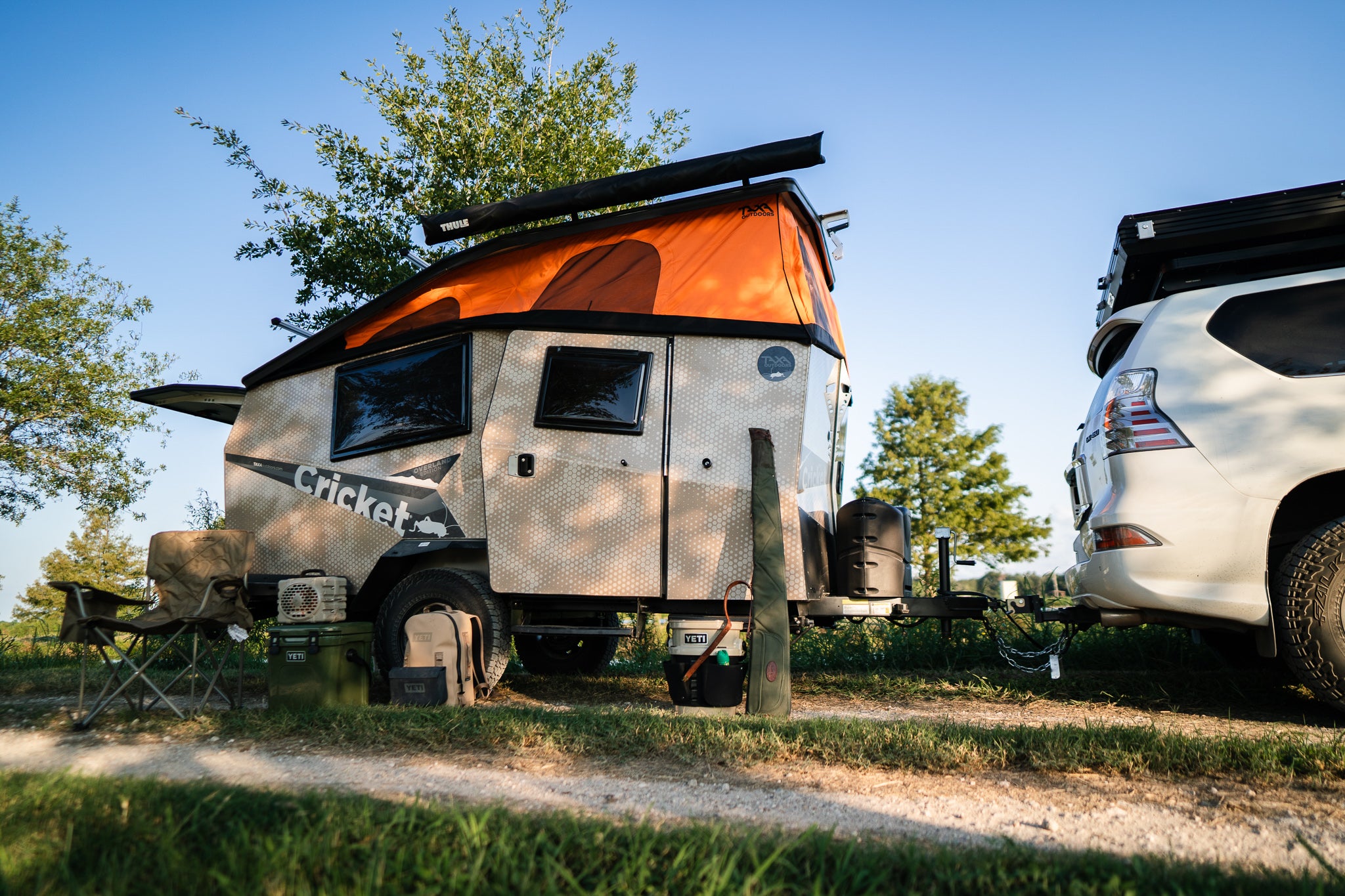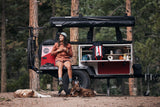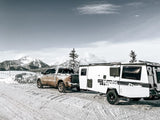Perhaps the most accessible category of RV or trailer products, pop-up campers are incredibly versatile. From camping trips to overlanding and much more, they’re a great way to experience the outdoors without sleeping on the cold, hard ground. Thinking of investing in a pop-up camper? Keep reading to learn more about how they’re defined, their pros and cons, and other FAQs you might be asking!
What is a pop-up camper?
Pop-up campers (also sometimes referred to as tent trailers, fold-out campers, and more) are a style of towable trailer that typically has a collapsable roof. This allows for plenty of internal space when set up, but a reduced height and size when not in use — which comes with a number of benefits that we’ll discuss in more detail. There are a wide variety of sizes, amenities, and uses when it comes to pop-ups, but there are some general considerations to keep in mind if you’re thinking about buying one.
How much does a pop-up camper weigh?
As a benchmark or rule of thumb, you can use 2,000 lbs as the average weight of pop-up models. Of course, there are pop-up campers on either side of this, really just depending on size and features. For example, our Cricket model with a pop-up roof has a dry weight of about 1,750 lbs, while our Mantis habitat (also with a pop-up roof) has a dry weight of a little over 3,000 lbs.
Pros & cons of pop-up campers
With this baseline understanding of tent campers, we can go over the pros and cons of these models. There are obvious weight and size advantages that you’ll have already picked up on, but there are plenty of other pros, as well as some cons to think about:
Advantages
- Affordable price – due to their relatively small size (both when set up as well as when collapsed), pop-up campers tend to have lower prices than larger trailers and RVs. This makes them more accessible as an entry point for those looking to get started with trailers.
- Lightweight – partially due to their physical size, but also due to their simplicity and the use of materials like canvas for the sides (rather than metal), pop-ups are typically much lighter than hard-sided trailers and RVs.
- Safer and easier to tow – being lighter means that more vehicles can tow these campers, and with better MPG than larger trailers. Most pop-up campers can be towed by the majority of cars on the road, but are also much less likely to fishtail or jackknife if hit by high winds or not loaded properly.
- Less complicated maintenance – the simplicity of these pop-ups means that you don’t have as many appliances and systems that can break and need repairs. However, some do have more complex mechanisms to raise and lower the roof that can introduce additional maintenance or issues.
- Still available with AC or heating – depending on the size and cost of your pop-up camper, there are certain models with limited temperature controls, which can really come in handy on those cold nights or hot afternoons.
- Easier (and cheaper) to store – although we pride ourselves on making all of our trailers “garageable” and able to fit within a standard garage, storage can be an expensive pain with other trailers. Being able to collapse a pop-up camper means that it will probably fit in your garage and you don’t have to worry about storage facilities, HOAs, or other complications.
- Feels like sleeping outside – while you might have the option to warm or cool your camper, the appeal of pop-ups is how close they are to traditional tents and camping. In other words, the purpose is to feel like you’re sleeping in nature with only the essentials and nothing more.
Drawbacks
- Feels like sleeping outside – on the other hand, that lack of “extras” can definitely be a disadvantage, depending on who you ask. Bad or unexpected weather can make sleeping in a pop-up camper a nightmare for those not prepared, not to mention the noise (both natural and from things like a generator) that comes through the thin canvas sides.
- Tents/awnings still require diligent care – while we mentioned that maintenance is more straightforward than more complex trailers, the material that the tent sidings and awnings are made from can be a pain to care for. This is particularly true when there is rain or the material gets wet, as you need to let everything sit out and air dry completely to avoid mildew.
- Typically no bathroom – tent campers’ size and selling point of being collapsible makes it difficult to include things like toilets, showers, and sinks. This is why most pop-up campers don’t have a bathroom, and ones that do typically utilize a “wet bath,” meaning that the shower and toilet are combined into one space.
- Limited sleeping capacity – again related to their size, these smaller campers usually don’t have space for more than a couple of people to lie down. However, some do have extensions to remedy this.
- Some locations have restrictions due to safety – unfortunately, there are a number of campsites and parks (such as Yellowstone) that have rules against pop-up trailers or exposed canvas campers due to safety concerns — especially in areas where bears and other predators are common. To get around this, there are hybrid campers (like Mantis and Cricket) that have pop-up capabilities but are hard-sided and comply with these restrictions, while still giving you the pop-up experience.
- Lighter pop-ups might tip over – another concern about having a primarily canvas camper is that in windy conditions, it can act like a sail. When these campers don’t have a strong or heavy enough base, there have been instances of pop-ups being tipped over.
- More setup and teardown time – because pop-up trailers collapse and fold up for storage and travel, you can’t just pull up to a campsite and start using the camper after a long trip. There is much more time required to actually expand, set up, and organize the camper (and the inverse for teardowns) compared to traditional trailers or RVs.
Other pop-up camper FAQs
If you’ve weighed the pros and cons of these types of campers and are considering investing in one or getting more information, there are some other important questions you might be asking:
How long do pop-up campers last?
When taken care of and kept up to date on maintenance, a good pop-up camper should last 10-15 years, or even more. However, this drastically decreases if you don’t stay on top of things like the tent condition, winterizing, and more — not to mention the costs of fixing the issues these bring.
Do they come with a bathroom?
As mentioned in the pros and cons section, most pop-up campers don’t have bathrooms due to their size and price. However, there are larger pop-ups (or smaller hard-sided campers) that do have bathrooms, at least as an optional add-on.
Can you leave a pop-up trailer up all summer?
This might sound like a good idea to store your trailer “open” with the longer setup and teardown times that come with pop-ups, but the tent siding is much more likely to get punctured, damaged, or infested if left up for months on end.
Can you camp with a pop-up in the winter?
You can, although it’s generally not recommended due to the additional preparations and risks that come with it. Temperature is your biggest enemy, as it can obviously harm you, as well as damage things like propane tanks, water lines, and more. Also, keep in mind that snow can accumulate on the roof or sides and even collapse the tent under its weight.
Are pop-up campers worth it?
The answer to this will really depend on what you’re looking for in an outdoor experience. If you’re looking for the most comfort with tons of amenities, probably not. If you want a more “one with nature” trip but don’t want to sleep on the ground, or you’re looking for an entry camper to get started, pop-up trailers might be exactly what you’re looking for.
Get the best of a pop-up camper without the drawbacks
There are tons of upsides to pop-up trailers, especially for those looking to experience nature without all of the frills and amenities of expensive RVs. However, some of the restrictions and disadvantages they bring can make a decision about what to get difficult. Mantis and Cricket are great hybrids that provide the lightweight advantage and easy storage of pop-ups, without the downsides of canvas sides and long setup times. Learn more about our habitats or take a look at our financing options today!


